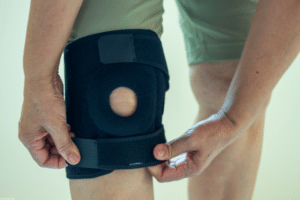If you’re dealing with persistent ankle pain, you may have encountered either an ankle strain or sprain. While these terms are commonly mixed up, it’s vital to understand the key differences. At Physiopros Oakville, Our dedicated team, led by registered physiotherapist Paul Wnuk, offers natural and effective ankle pain treatment and prevention through physiotherapy.
In this article, we’ll clarify the distinctions between ankle strains and sprains, and how physiotherapy can provide relief and recovery.


Understanding Ankle Sprains and Strains
Ankle Sprains: An ankle sprain typically occurs when the ligaments that connect the bones in the ankle are stretched or torn due to sudden twisting or rolling movements. Common causes include sports-related incidents, uneven terrain, or accidents. Symptoms of a sprained ankle include pain, swelling, bruising, and difficulty bearing weight on the affected ankle.
Ankle Strains: On the other hand, an ankle strain involves damage to the muscles or tendons around the ankle joint. Strains often result from overstretching or overuse of these tissues. Symptoms may include pain, stiffness, and muscle weakness around the ankle area.
How common are ankle injuries in North America?
Half of all ankle sprains occur during an athletic activity. Every day in the U.S., 25,000 people sprain their ankle. And more than 1 million people visit emergency rooms each year because of ankle injuries. The most common ankle injuries are sprains and fractures, which involve ligaments and bones in the ankle.
Book your appointment now at Physiopros Oakville
The Role of Physiotherapy in Ankle Injury Management
Physiotherapy plays a crucial role in the rehabilitation of both ankle sprains and strains. Here’s how registered physiotherapist Paul Wnuk and our team at Physiopros Oakville can help:
Accurate Diagnosis: Our certified physiotherapists will assess your condition, including the severity of the injury, through a comprehensive examination. This evaluation ensures a tailored treatment plan designed to meet your specific needs.
Pain Management: Physiotherapy techniques, such as manual therapy and modalities like ice and heat, can help alleviate pain and reduce inflammation, providing immediate relief.
Strengthening Exercises: We will prescribe exercises to improve muscle strength, stability, and flexibility around the ankle joint. These exercises not only aid in recovery but also reduce the risk of future injuries.
Balance and Proprioception Training: Regaining balance and proprioception (awareness of body position) is essential in preventing re-injury. Our physiotherapists will guide you through exercises to enhance your ankle’s stability and coordination.
Customized Rehabilitation Plans: Each patient is unique, and so are their injury and recovery needs. We create personalized rehabilitation plans to address your specific concerns and goals.
Common Symptoms of strain or sprain
The symptoms of a sprain and a strain can be similar, as both are injuries to soft tissues, but there are some differences. Here are the typical symptoms of each:
Sprain (Ankle Sprain, for example):
- Pain: Sudden onset of pain at the time of injury.
- Swelling: Swelling around the affected joint, which may develop rapidly.
- Bruising: The injured area may become bruised due to damaged blood vessels.
- Limited Range of Motion: Difficulty moving the affected joint normally.
- Tenderness: The area is sensitive to touch, and there may be pain when pressure is applied.
- Instability: Feeling of joint instability or “giving way” if the ligament is severely damaged.
Strain (Muscle or Tendon Strain, for example):
- Pain: Immediate or delayed onset of pain during or after physical activity.
- Muscle Stiffness: The affected muscle may feel stiff and tight.
- Swelling: Swelling can occur but is generally less pronounced than with a sprain.
- Muscle Weakness: Difficulty using the muscle due to pain and weakness.
- Muscle Spasms: In some cases, muscle spasms or cramps may occur.
- Tenderness: Tenderness at the site of the injury.

FAQs about Ankle Sprains and Strains
The recovery time varies based on the severity of the injury. Mild cases may take a few weeks, while more severe injuries can take several months. Our registered physiotherapist at Physiopros Oakville will provide a more accurate estimate during your evaluation.
Yes, physiotherapy can help you develop strength and flexibility to reduce the risk of future injuries. Our team will provide guidance on preventive exercises and techniques.
Surgery is usually reserved for severe cases when conservative treatments are ineffective. Physiotherapy is often successful in managing and healing ankle injuries without the need for surgery.







